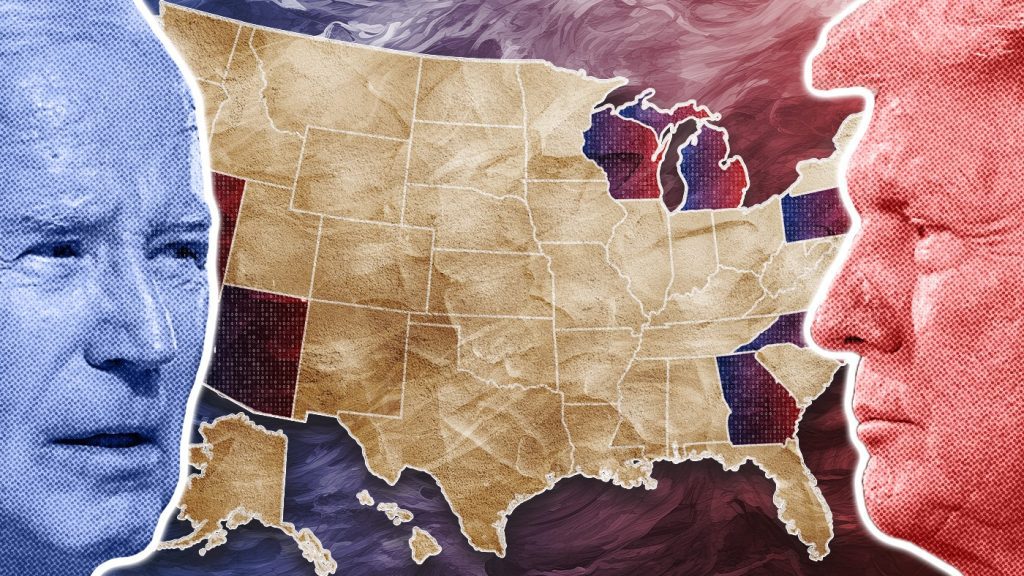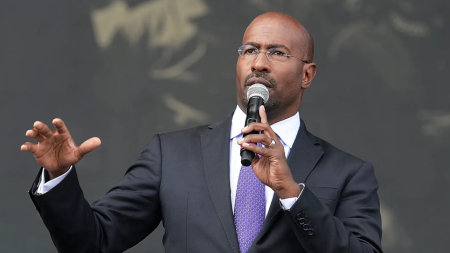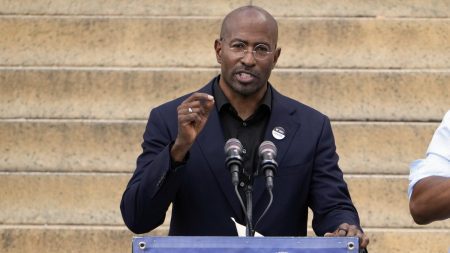The competition between President Biden and former President Trump is intensifying as the general election for the White House is now in progress.
Last month, Biden and Trump easily secured their party’s expected nominees, but both candidates will have a challenging campaign ahead in a rematch of the 2020 contest. A few battleground states are likely to decide the winner in this extremely close race.
Biden won almost all of them on his way to victory four years ago, but so far, polls have mostly shown Trump leading in each of them.
This is the current polling situation in the seven battleground states:
Arizona
Arizona was a crucial target for Democrats in the 2020 presidential election. Biden successfully flipped it by less than a percentage point, even though the state had not voted for a Democratic presidential candidate since 1996.
This year, it will be a fiercely contested state for its 11 electoral votes, being the only true battleground state on the U.S. southern border. A Gallup poll from February indicated that more Americans saw immigration as the most important issue facing the country, compared to any other topic, for the first time since 2019.
Trump has has kept an advantage in The Hill/Decision Desk HQ polling average of the state by a few points since October. He leads in the average by nearly 5 points and led by a similar margin in a poll from The Wall Street Journal released Wednesday.
The significant growth of Hispanic voters was considered crucial in putting Arizona in play for Democrats. However, polling and election results indicating a shift to the right among this crucial demographic nationwide could create a challenge for Biden to retain the state in 2024.
Georgia
Similar to Arizona, Democrats achieved a favorable and long-awaited outcome in Georgia in 2020 when Biden turned the state Democratic for the first time since 1992. He won by the narrowest margin of any state that year, with a victory of just over two-tenths of a point.
Trump is leading by 5 points in the state’s polling average from The Hill/Decision Desk HQ and has consistently been ahead in polls conducted in the state. However, the most recent ones have indicated his lead within or close to the margin of error. Trump was ahead by 3 points, 51 percent to 48 percent, among likely voters in a YouGov/CBS News poll last month, but the margin of error was 3.9 points.
He was ahead by 4 points in another poll from Emerson College Polling/The Hill with a margin of error of 3 points. However, Trump’s lead increased to 7 points when third-party candidates Robert F. Kennedy Jr., Cornel West and Jill Stein were included.
Mobilizing Black voters was crucial for Biden to secure the state’s 16 electoral votes, but polls have indicated that he is not as successful with the demographic in this election cycle.
The CBS poll showed 17 percent of Black voters choosing Trump, an improvement from his performance with the group four years earlier.
Biden’s campaign has intensified efforts to reach Black voters and other voters of color to maintain this crucial part of its coalition, but the current numbers suggest that the campaign has work to do.
Michigan
Michigan was part of the "blue wall" of Midwestern states that usually voted for Democrats but voted for Trump in 2016.
Biden won it back in 2020 by a small but decent margin, taking it by nearly 3 points. He connected with union workers, auto workers, and minority groups to win the state.
But Biden's path to securing Michigan’s 16 electoral votes has become more complex this time. Trump leads by about 4 points in The Hill/Decision Desk HQ’s polling average.
Biden got a key endorsement from United Auto Workers but still needs to win over union members dealing with inflation affecting their cost of living and those who are not enthusiastic about his electric vehicle policies.
Biden is also struggling with Arab American voters frustrated with the administration’s support for Israel in its war against Hamas, and his approval rating among this demographic plunged in the weeks following the outbreak of the war in October. Michigan has one of the largest populations with ancestry in the Middle East and North Africa in the country — greater than his margin of victory in the state in 2020.
But some of the recent polls may indicate added hope for Biden here. Biden and Trump were almost tied when undecided voters were required to choose in an Emerson College Polling/The Hill poll from last month, and they were tied in a North Star Opinion Research poll from February.
Nevada
Nevada has consistently voted for the Democratic presidential candidate in every election since 2008, but it has been especially close in both 2016 and 2020. Biden won it last time with just more than a majority of the vote.
Trump has been leading the state in polls but mostly by the low-to-mid single digits. He was up by just 2 points in a Bloomberg News/Morning Consult poll from last month, and he led by 3 points in an Emerson College Polling/KLAS-TV/The Hill poll.
Trump leads in the polling average from The Hill/Decision Desk HQ by just less than 4 points.
Like in Arizona, Biden owes a certain amount of his victory in Nevada to support among Latino voters. Democrats’ ability to hold off Republican attempts to gain with this group will be key to Biden keeping the state in his column.
The Emerson poll had Biden leading among Hispanic voters by 5 points, 44 percent to 39 percent.
North Carolina
The Tarheel State has been a story of “close but no cigar” on the presidential level for Democrats. The party has fallen just short of winning the state’s electoral votes three cycles in a row since Barack Obama won it in 2008. But it is a key battleground again and will likely be Biden’s best chance to flip a state he lost in 2020.
Trump was leading in The Hill/Decision Desk HQ polling average by a sizeable margin for the first few months of 2024, reaching 10 points at one time, but Biden has been closing the margin recently. Trump’s lead currently stands at about 5 points.
Trump led by 3 points, within the margin of error, in a Marist College poll from last month, but he led by 6 points in the Journal poll from Wednesday.
Strategists in October pointed to both the state’s Black and growing Latino populations as key to getting Democrats across the finish line in North Carolina, with one saying he expects the focus on the state to be even more intense than in previous years.
Pennsylvania
Pennsylvania is the most important state in the battlegrounds in terms of electorally valuable. It offers 20 electoral votes to the candidate who wins it, and it was a crucial factor in Trump's win in 2016 and Biden's in 2020.
The Keystone State, which had not voted for a Republican presidential candidate since 1988, surprised many by going red for Trump in 2016 by less than 50,000 votes. Biden was able to turn it back, but barely by 1 percentage point.
Recent polling in Pennsylvania has been more hopeful for Biden than in many other states. Trump is ahead by only 1.3 points in the Hill/Decision Desk HQ polling average.
In a CNN/SRSS poll and a Bloomberg News/Morning Consult poll from last month, Biden and Trump were tied. Trump led by 3 in the Journal poll from Wednesday, while Biden led by 5 in a Susquehanna Polling & Research survey released last week.
Previous polls have shown small leads for both Trump and Biden over the months, so the polling average consistently shows a tight race with neither candidate leading by more than a few points.
Wisconsin
In 2020, Wisconsin was the closest state that Biden reclaimed to rebuild the Midwestern “blue wall,” winning it by about 20,000 votes. He is currently performing comparatively better there in polling than in most other battleground states.
In the Hill/Decision Desk HQ’s polling average, Trump leads by 1.6 points, slightly less than the lead he has held since late January. Recent polling results in the state have regularly been within the margin of error, showing each candidate slightly ahead at times.
According to the Journal poll, Wisconsin was the only state where Biden was not trailing. He and Trump were tied at 46 percent in a head-to-head match-up, and he led by 3 points when independent candidate Robert F. Kennedy Jr. was included in a three-way race.
The Biden campaign has stressed that it is too early to focus on polling, but Pennsylvania and Wisconsin should give them the most optimism at this point.









